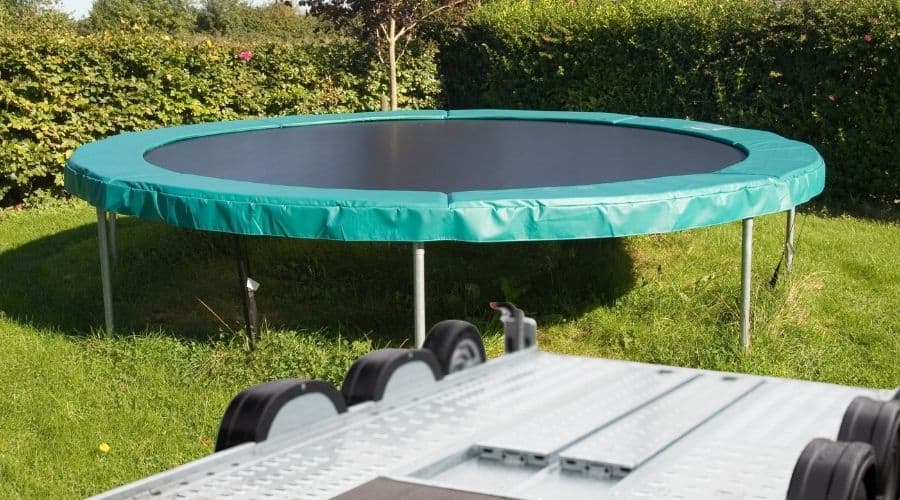Most people move their trampolines by taking them apart and packing the pieces away for reassembly at a new location, and there’s nothing wrong with that. Disassembly is slow but sensible. However, there are other ways. How do you move a trampoline on a trailer?
I will explain everything you need to know and provide a step-by-step process to follow so your trampoline arrives at our new home undamaged and easy to set up.
A trampoline can be moved on trailer without taking it apart however you must first double check that the trailer matches the width of your trampoline. Because trampolines are relatively lightweight, you’ll need to secure yours evenly all around the frame with straps to avoid damage.
Table of Contents
Can You Move A Trampoline On A Trailer
You can move a trampoline on a trailer, or more importantly, you can move some fully assembled trampolines on some trailers.
If the size of your trampoline is more expansive than your trailer, you’re going to have issues with the sides hanging off.
While most states allow you to have at least 2 to 3 feet of rear overhang and sometimes front overhang, items sticking off the sides are frowned upon and often illegal.
One way to solve this is to put your trampoline on the trailer sideways. However, doing this can cause frame warping, so you’ll have to do repairs when you arrive at the new location.
A bent trampoline frame is not safe for jumping on. Plus, bending the metal makes it more prone to breakage.
Physics Stack Exchange explains the phenomenon, “…when you are bending a piece of wire up and down, you are plastically deforming the metal. This causes crystal imperfections called dislocations in the metal to move about within the crystal grains and to get piled up and trapped at the edges of the grains.”
Is It Easy To Move A Trampoline On A Trailer
If your trampoline fits properly, moving a trampoline on a trailer is extremely easy.
Tying down a trampoline is no more difficult than other oversized items, though it’s a lot lighter. Unfortunately, there are three significant downsides to using this method you should know about.
First, renting a large trailer is often prohibitively expensive. It will run you $100 or more per day, though you can save a little money renting weekly.
That is the price before taxes and any additional fees like insurance.
Secondly, tieing down a large, somewhat fragile object like a trampoline is time-consuming and delicate work.
If you don’t spread the weight evenly, you’ll have a twisted mess. Sadly, you usually can’t tie anything else there while transporting a trampoline.
Third and finally, choosing to move a fully assembled trampoline is ponderously slow. You cannot drive anywhere quickly because the net poles, and other parts, can easily bend in the wind.
How Do You Haul A Trampoline On A Trailer
Figuring out how to haul a trampoline on a trailer isn’t tricky.
However, if you have no experience with this type of moving, it requires a little bit of knowledge to keep your trampoline from coming loose and flying off the bed.
Follow the steps below to get your trampoline transported easily.
1 – Measure
Regardless of whether your tailer is round, square, or rectangular, you need to measure it.
For a round trampoline, measure across the top from one side to the other at the broadest point since it will be the same no matter which direction you go.
For a square trampoline, you can measure corner to corner.
A rectangular trampoline needs to be measured along the short and long sides. Don’t forget to take note of the measurements.
It would be best if you had a trailer that is both long enough and wide enough for your trampoline to sit on it without overlapping the sides.
If your trampoline hangs off the end, you must mark it appropriately.
According to Camera Source, “Using the United States Department of Transportation’s Federal Size Regulation law as a general guideline, oversized loads like lumber that exceed an overhang of 3 feet to the front, 4 inches to the side, or 4 feet to the rear must be marked by a white, red, yellow or orange fluorescent flag.”
2 – Set It On The Bed
For large trampolines, it’s a good idea to work with a partner to set your toy on the trailer.
Carefully lift the whole trampoline off the ground and walk it over to the bed.
With one person moving backward, have them step up onto the back end and follow so that the whole trampoline is on the trailer without any overlap.
3 – Locate Your Tie-Down Points
Most trailers have a rail that extends all the way around three sides. You’ll need this to tie your trampoline down.
This is also an excellent time to securely attach your rope or long bungee cords and attach them to the trampoline’s frame near the mat.
4 – Tie It Down
Starting with the four corners of the trailer, you want to attach opposite corner tie-downs in place, so the trampoline is secured.
After that, you should also use at least one set of additional tie-downs to hold the sides in place.
Ensuring your trampoline has no wiggle room and stays firmly in place is vital.
5 – Take It Slow
Trampolines have a lot of surface area, and they are very lightweight. Unfortunately, this means they catch air easily and are prone to flying away.
If your tie-downs are not secure or you catch too much wind, the trampoline will fly away like the unsecured trampolines in this video from iCK.
Keep your speed slow, and make sure you watch out the rear mirrors regularly to check on your trampoline.
You cannot tie anything else down to the trailer with your trampoline. However, you may want to secure a few canopy weights to the base of the legs to help keep it in place.
- Made in the USA from recycled plastic material and filled with cement
- Includes four 7.5 lb. weights for 30 lbs. total weight does not include carry strap. Each individual weight is 9”L x 9”W x 2.225”H
- The original No-Pinch design makes for easy, safe installation and removal of weights
- Fits all canopy poles up to 1 1/4 inch wide
- Interlocking weights designed by the experts securely fit the canopy legs
Last update on 2024-04-27 / Affiliate links / Images from Amazon Product Advertising API
Helpful Tips To Know About Moving A Trampoline On A Trailer
Moving a trampoline on a trailer can be a perfectly sensible way to move this sizeable outdoor toy, especially if you own a trailer that can accommodate it.
Here are more helpful tips to know about moving a trampoline on a trailer.
- You may not want to use ratcheting tie-downs for your trampoline. Using rope or bungee cords instead is better because the ratcheting tie-downs put extra pressure on whatever you are securing. If you over-tighten your straps, which is all too easy, you’ll bend your trampoline’s frame from the added stress.
- It is better to move a trampoline on a trailer if you are going a relatively short distance, less than a hundred miles or so. Because you have to drive much more slowly, a very long haul would not be sensible for most people, such as cross country.
- If you are uncertain or don’t want to risk moving your own trampoline, professional trampoline movers and other pro movers can help you with this job.
Final Thoughts
Moving a trampoline on a trailer is possible. Moreover, it’s a pretty straightforward process, but it’s also delicate work because you don’t want to damage the trampoline in moving it.
You can fix a bent, out-of-shape trampoline frame, but it’s also more likely to break than its unbent counterparts.
However, being secure isn’t the only challenge for this type of move. It’s essential to ensure that your trailer is wide enough to accommodate the entire trampoline without side-to-side overlap.
Yet even with all those precautions, you’ll still need to drive slowly to avoid wind damage.


